Back to Product Category
|
|
|
Wide-Lift
(WL) Slings |
All
Wide-Lift Slings offer these benefits: |
|
|
|
|
Promotes
Safety |
|
| Wide
Load Support and Balance |
|
|
|
|
• Red Core Yarn warning system aids in the inspection
process
• Tuff-Tag provides serial numbered identification
for
traceability
• Improved load stabilization |
|
Wide-Lift
slings support the load over a wide area
to offer better balance for large loads - whether heavy
or light. Wide bearing area reduces marring of soft load
surfaces. Stiffeners are used at the base of the eyes to
deter the body webbing from folding down the middle.
Wide-Lift slings are for use in basket hitch only.
Standard web material is Webmaster 1600 nylon.
Polyester is available upon request. |
|
|
|
| Saves
Money |
|
|
|
• Wide bearing area reduces marring of soft load
surfaces
• Yellow treatment for abrasion resistance
and extended
sling life
• Tuff-Tag provides required OSHA information
for
the life of the sling, not just the life of the tag |
|
|
|
|
 |
|
For
Light, Bulky Loads - Lifting eyes are attached to a
single ply sling body. Available with One Ply eyes
(WLA1) or Two Ply eyes (WLA2). |
|
|
|
|
*PRICE
UPON REQUEST* |
|
|
|
|
|
|
| |
Body
Width
(in.) |
Part No. |
Rated
Capacity*
(lbs.) Vertical
Basket |
Eye
Length
(in.) |
Min.
Sling
Length
(in.) |
|
|
Body
Width
(in.) |
Part No. |
Rated
Capacity*
(lbs.) Vertical
Basket |
Eye
Length
(in.) |
Min.
Sling
Length
(in.) |
One
Ply
Eye |
6 |
WLA1806N |
5,000 |
10 |
50 |
One
Ply
Eye |
6 |
WL1806N |
15,400 |
9 |
40 |
| 8 |
WLA1808N |
5,000 |
10 |
50 |
8 |
WL1808N |
20,400 |
12 |
45 |
| 10 |
WLA1810N |
5,000 |
12 |
54 |
12 |
WL1812N |
30,800 |
18 |
60 |
| 12 |
WLA1812N |
5,000 |
12 |
56 |
16 |
WL1816N |
38,000 |
24 |
72 |
| 16 |
WLA1816N |
10,000 |
12 |
56 |
20 |
WL1820N |
45,000 |
30 |
88 |
| 20 |
WLA1820N |
10,000 |
18 |
68 |
24 |
WL1824N |
52,000 |
36 |
100 |
| 24 |
WLA1824N |
10,000 |
18 |
72 |
30 |
WL1830N |
45,000 |
45 |
120 |
| |
6 |
WLA2806N |
10,000 |
10 |
50 |
36 |
WL1836N |
45,000 |
54 |
144 |
| Two Ply Eye |
8 |
WLA2808N |
10,000 |
10 |
50 |
Two Ply Eye |
6 |
WL2806N |
28,600 |
9 |
40 |
| 10 |
WLA2810N |
10,000 |
12 |
54 |
8 |
WL2808N |
38,000 |
12 |
45 |
| 12 |
WLA2812N |
10,000 |
12 |
56 |
12 |
WL2812N |
57,200 |
18 |
60 |
| 16 |
WLA2816N |
18,000 |
12 |
56 |
16 |
WL2816N |
75,000 |
24 |
72 |
| 20 |
WLA2820N |
18,000 |
18 |
68 |
20 |
WL2820N |
90,000 |
30 |
88 |
| 24 |
WLA2824N |
18,000 |
18 |
72 |
24 |
WL2824N |
110,000 |
36 |
100 |
| 30 |
WLA2830N |
18,000 |
18 |
72 |
30 |
WL2830N |
90,000 |
45 |
120 |
| 36 |
WLA2836N |
18,000 |
22 |
88 |
36 |
WL2836N |
90,000 |
54 |
144 |
| 48 |
WLA2848N |
18,000 |
30 |
122 |
|
|
Note:
1. Never use Wide-Lift slings in a choker hitch.
2. Custom slings with higher capacities are available.
3. Tuflex® slings can also be designed in a Wide-Lift configuration. |
|
CALL
OUR SALES DEPARTMENT
FOR A QUOTE |
|
|
|
Do
not exceed rated capacities. Sling tension increases as the angle from horizontal
decreases.
Slings should not be used at angles of less than 30°. Refer to the Effect
of Angle chart at the
bottom of this page. Always protect synthetic slings from being cut by corners
and edges.
See the Sling Protection section below. |
 * * |
|
|
Sling
Protection |
|
CUT
AND WEAR PROTECTION |
|
|
|
|
|
| Selection
of Sling Protection Products |
|
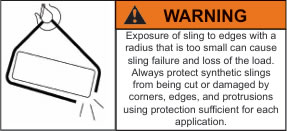 |
|
Sling
protection products need to be used in applications where sling
damage may occur. Cutting of synthetic slings during use is the number
one cause of sling accidents. A variety of factors influence sling
protection performance. Since no material is fully cut proof, a qualified
person must select materials and methods that adequately protect
slings from edges or surfaces. We can assist customers with their
product selections. |
|
|
|
|
|
|
|
| Cut
Protection versus Wear Protection |
|
|
Our
sling protection products are divided into two categories, Cut Protection
and Wear Protection. Cut Protection
Products are designed to improve workplace safety. When placed between slings
and edges, cut protection products
act as a buffer to prevent sling cutting and to reduce bearing pressure
levels at contact areas. Wear protection
products serve to extend sling life by reducing abrasive wear and prevent
marring of the load surfaces.
The following table provides comparative sling protection performance for
standard products. |
|
|
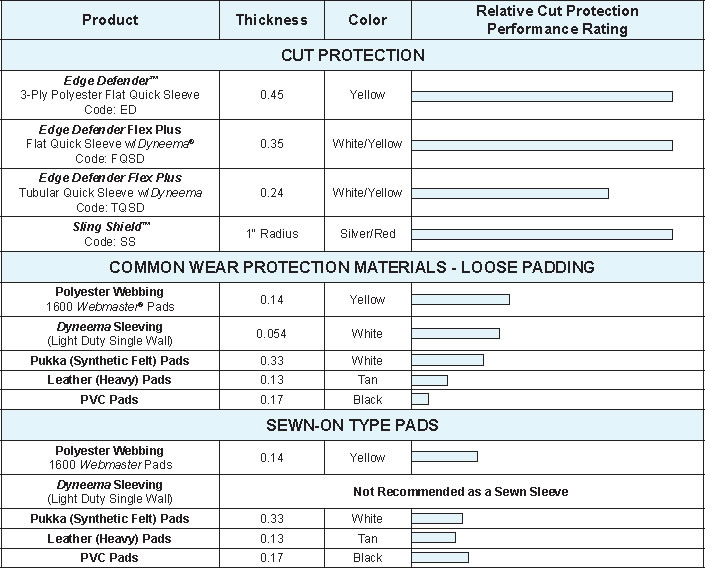 |
Performance
Rating: The bar graphs shown above reflect the comparative performance
of Our Cut Protection
products against commonly used loose and sewn-on types of Wear Protection
products.
Test Lift Qualification: To validate the suitability of sling protection
products for each application, always
complete one or more test lifts in a non-consequence manner.
Technical Bulletin MS-10 available for additional information. |
|
|
|
|
|
|
|
|
|
|
| EFFECT
OF SLING ANGLE |
|
|
|
|
|
|
|
|
|
Using
slings at an angle can become deadly if that angle is not taken into
consideration when selecting the sling to
be used. The tension on each leg of the sling is increased as the angle
of lift, from horizontal, decreases. It is most
desirable for a sling to have a larger angle of lift, approaching 90°.
Lifts with angles of less than 30° from horizontal
are not recommended. If you can measure the angle of lift or the length
and height of the sling as rigged, you can
determine the properly rated sling for your lift. The Increased Tension
method provides the increased tension as a
function of the sling angle. Alternatively, the sling Reduced Capacity method
may be used to determine reduced lift
capacity for any angle. |
|
|
|
|
|
|
|
|
|
INCREASED
TENSION
Determine capacity
of sling needed |
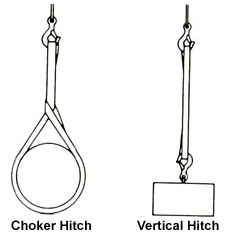 |
REDUCED
CAPACITY
Calculate rating of each sling
rigged at this angle |
|
|
|
|
|
| 1.
Determine the load weight (LW). |
1.
Calculate the reduction factor (RF). |
|
|
|
|
a.
Using the angle from horizontal,
read across the Angle Chart to
the corresponding number of the
Reduction Factor column. |
| 2.
Calculate the Tension Factor [TF]. |
|
|
a.
Determine the sling angle as mea-
sured from the horizontal, and the
corresponding tension factor (TF)
from the effect of angle chart. |
|
|
|
-OR- |
|
|
b.
Divide sling height* (H) by sling
length* (L). |
|
-OR- |
|
|
|
b.
Length* (L) divided by height*
(H) |
|
|
|
|
|
2.
Reduction factor (RF) x the sling’s
rated capacity for the type hitch that
will be used = sling’s reduced rating. |
|
|
|
|
|
|
|
|
|
|
|
|
3.
Determine the share of the load
applied to each sling leg (LW). |
|
|
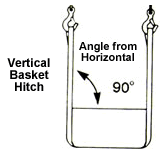 |
|
|
|
|
|
|
|
|
|
|
|
|
|
|
4.
Multiply (LW) by (TF) to determine
the sling leg tension. The capacity of
the selected sling or sling leg must
meet the calculated tension value. |
|
|
*Measured
from a common horizontal
plane to the hoisting hook. |
|
|
|
|
|
|
|
|
|
|
|
|
*Measured
from a common horizontal plane
to the hoisting hook. |
|
|
|
|
|
|
|
|
|
|
|
|
|
|
|
|
 |
|
Effect
of Angle Chart |
|
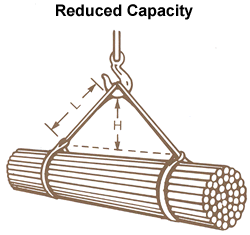 |
|
|
Tension
Factor (TF) |
Angle From
Horizontal |
Reduction
Factor (RF) |
| 1.000 |
90º |
1.000 |
| 1.004 |
85º |
0.996 |
| 1.015 |
80º |
0.985 |
| 1.035 |
75º |
0.966 |
| 1.064 |
70º |
0.940 |
| 1.104 |
65º |
0.906 |
| 1.155 |
60º |
0.866 |
| 1.221 |
55º |
0.819 |
| 1.305 |
50º |
0.766 |
| 1.414 |
45º |
0.707 |
| 1.555 |
40º |
0.643 |
| 1.742 |
35º |
0.574 |
| 2.000 |
30º |
0.500 |
|
|
|
|
|
|
|
|
|
Example: |
|
|
|
Vertical
Choker rating of each sling:
6,000 lbs.
Measured Length (L) = 6 ft.
Measured Height (H) = 4 ft.
Reduction Factor (RF) = 4 (H) ÷ 6 (L) = .667 |
|
|
|
|
| Example: |
|
|
|
Load
weight = 1,000 lbs.
Rigging - 2 slings in vertical hitch
Lifting Weight (LW) per sling = 500 lbs.
Measured Length (L) = 10 ft.
Measured Height (H) = 5 ft.
Tension Factor (TF) = 10 (L) ÷ 5 (H) = 2.0
Minimum Vertical Rated Capacity required
for this lift = 500 (LW) x 2.0 (TF) = 1000 lbs.
per sling |
|
Sling
capacity decreases as the angle
from horizontal decreases. Sling angles
of less than 30° are not recommended. |
|
|
Reduced
sling rating in this configuration
= .667 |
|
(RF)
x 6,000 lbs. = 4,000 lbs. of lifting
capacity per sling |
|
|
|
|
|
|
|
Wide Lift Slings, Webmaster
1600 Slings, Lifting Slings, Sling, Nylon Slings, Lift-All, Nylon and
Polyester Slings, Industrial
Standard Heavy Duty Sling, Synthetic Web Slings, Serial Numbered Identification,
Triangles and Chokers, Eye and Eye Slings,
Flat Eye, Twisted Eye, and Endless Slings from your source for material
handling equipment. |
Back to Product Category
|



